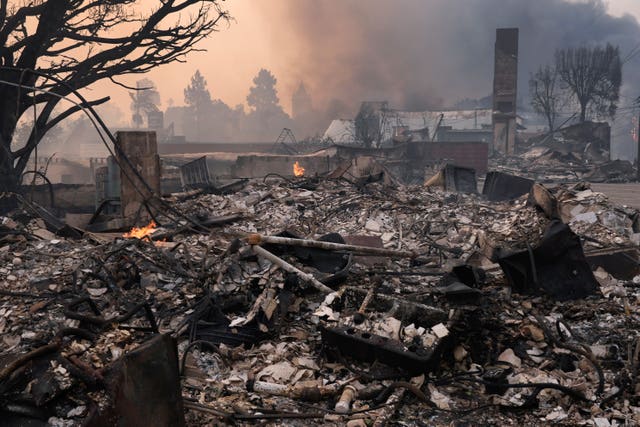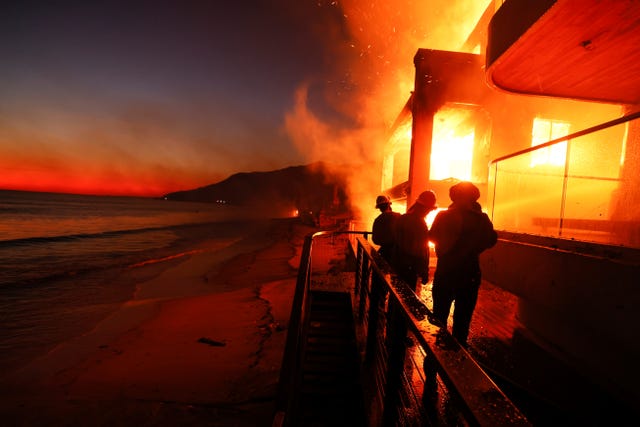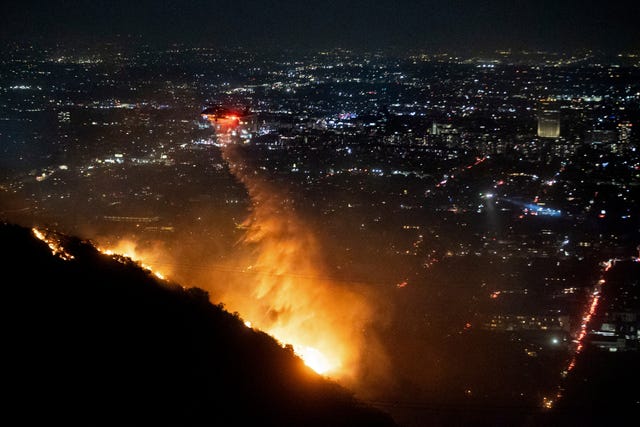A fast-moving fire broke out in the hills above Hollywood Boulevard and threatened some of the most popular Los Angeles tourist spots as firefighters battled to get control of two other major blazes that killed five people, put 130,000 people under evacuation orders and ravaged communities from the Pacific Coast to inland Pasadena.
The Sunset Fire started around 5.45pm local time on Wednesday as officials were holding a news conference to update residents on efforts to fight massive blazes in Pacific Palisades and Altadena and to warn that the fire danger remained high. Los Angeles Fire Department Chief Kristin Crowley made a hasty exit after announcing the new fire and soon after an evacuation order was issued.
The Hollywood Walk of Fame was bustling and the streets around the TCL Chinese Theatre and Madame Tussauds were packed with stop-and-go traffic as sirens blared and low-flying helicopters flew overhead to dump water on the flames, which were only about a mile away. People toting suitcases left hotels while some onlookers walked toward the flames, recording the fire on their phones.
A day earlier, hurricane-force winds blew embers through the air, igniting block after block in the Los Angeles coastline neighbourhood of Pacific Palisades and about 25 miles (40km) to the east in Altadena, an unincorporated community near Pasadena.
Nearly 2,000 homes, businesses and other structures have been destroyed in the Eaton and Palisades fires, and the number is expected to increase. The five deaths recorded so far were from the Eaton Fire.
The Palisades Fire is already the most destructive in Los Angeles history, with at least 1,000 structures burned.

Los Angeles mayor Karen Bass said air operations were dousing flames. She warned they still faced “erratic winds”, although not like Tuesday evening, when aircraft had to be grounded and much of the destruction occurred.
In Pasadena, Fire Chief Chad Augustin said the city’s water system was stretched and was further hampered by power outages, but even without those issues, he said firefighters would not have been able to stop the fire due to the intense winds fanning the flames.
“Those erratic wind gusts were throwing embers for multiple miles ahead of the fire,” he said.
As flames moved through his neighbourhood, Jose Velasquez sprayed down his family’s Altadena home with water as embers rained down on the roof. He managed to save their home, which also houses their family business selling churros, a Mexican pastry. Others were not so lucky. Many of his neighbours were at work when they lost their homes.
We’re prepared to do anything and everything, as long as it takes, to contain the Southern California fires and help reconstruct. But we know it’ll be a hell of a long way.
The federal government is here to stay as long as you need us. pic.twitter.com/roLsYjKOki
— President Biden (@POTUS) January 9, 2025
“So we had to call a few people and then we had people messaging, asking if their house was still standing,” he said. “We had to tell them that it’s not.”
In Pacific Palisades, a hillside area along the coast dotted with celebrity homes, the scope of the destruction was just becoming clear.
Block after block of homes and bungalows were reduced to charred remains. Ornate iron railings wrapped around the smouldering frame of one property. Swimming pools were blackened with soot, and sports cars slumped on melted tyres.
The apocalyptic scenes spread for miles.
The flames marched towards highly populated and affluent neighbourhoods, including Calabasas and Santa Monica, home to California’s rich and famous.

“We raised our children and grandchildren here. Every inch of our house was filled with love. Beautiful memories that can’t be taken away,” the Crystals wrote in the statement.
In Palisades Village, the public library, two major grocers, a pair of banks and several boutiques were destroyed.
“It’s just really weird coming back to somewhere that doesn’t really exist anymore,” said Dylan Vincent, who returned to the neighbourhood to retrieve some items and saw that his primary school had burned down and that whole blocks had been flattened.
The fires have consumed a total of about 42 square miles (108 square kilometres) — nearly the size of the entire city of San Francisco.
Flames moved so quickly that many barely had time to escape. Police sought shelter inside their patrol cars, and residents at a senior living centre were pushed in wheelchairs and hospital beds down a street to safety.
In the race to get away in Pacific Palisades, roadways became impassable when scores of people abandoned their vehicles and set out on foot.
California’s wildfire season is beginning earlier and ending later due to rising temperatures and decreased rainfall tied to climate change, according to recent data.
Rains that usually end fire season are often delayed, meaning fires can burn through the winter months, according to the Western Fire Chiefs Association.
Dry winds, including the notorious Santa Anas, have contributed to warmer-than-average temperatures in Southern California, which has not seen more than 0.1 inches (2.5 millimetres) of rain since early May.
The winds increased to 80mph (129kph) on Wednesday, according to reports received by the National Weather Service. Forecasters predicted wind gusts of 35-55mph (56 to 88kph) that could rise higher in the mountains and foothills. Fire conditions could last through to Friday.

Several Hollywood studios suspended production, and Universal Studios closed its theme park between Pasadena and Pacific Palisades.
As of Wednesday evening, more than 456,000 people were without power in southern California, according to the tracking website PowerOutage.us.
Several Southern California landmarks were heavily damaged, including the Reel Inn in Malibu, a seafood restaurant. Owner Teddy Leonard and her husband hope to rebuild.
“When you look at the grand scheme of things, as long as your family is well and everyone’s alive, you’re still winning, right?” she said.






